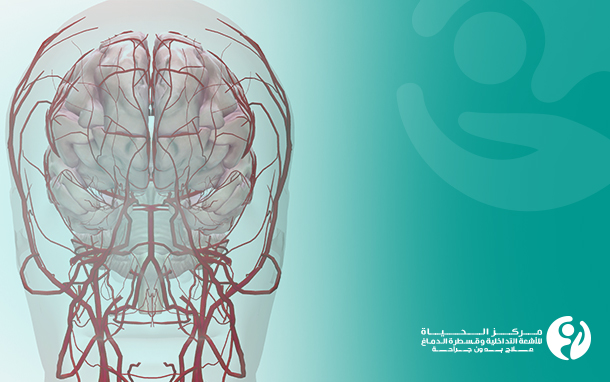Treatment of Cerebral Artery and Vein Stenosis
Cerebral arteriovenous stenosis refers to the narrowing or blockage of blood vessels in the brain. This condition can affect blood flow and blood supply to the brain, which can cause serious health problems.
Cerebral artery stenosis occurs when fat and cholesterol accumulate within the blood vessel walls, reducing the blood flow that carries oxygen and nutrients to the brain, thereby limiting the amount of blood reaching the brain. This blockage can be partial or complete and can lead to reduced blood supply to different parts of the brain, resulting in strokes.
Cerebral vein stenosis occurs when the veins that drain blood outside the brain become narrowed or obstructed. This narrowing can lead to increased blood pressure within the brain and blood accumulation, which puts pressure on brain tissue and affects brain function.
Cerebral artery and vein stenosis is a serious condition that can increase the risk of blood clots and strokes. Treatment of cerebral artery and vein stenosis has become dependent on inserting stents into the blood vessels as an alternative to surgical treatment.
What are the symptoms of cerebral artery stenosis?
Cerebral arteriosclerosis can cause multiple problems, due to the possibility of detachment of a portion of these fatty deposits and their migration to settle in a smaller artery in the brain. If the symptoms are transient and disappear within a few hours, this is called a minor stroke, but if they persist for longer, it is a full stroke.
It is difficult to predict the severity of the resulting problem because the situation varies depending on the location where these deposits settle. A patient suffering from this condition experiences stroke symptoms, characterized by the appearance of one or more of the following symptoms:
• Weakness in one arm, leg, face, or half of the body.
• Tingling or numbness in half of the body, half of the face, or one of the limbs.
• Difficulty speaking and understanding speech.
• Loss of vision in one eye or double vision.
• Difficulty with coordination and movement.
The sudden appearance of these symptoms requires seeking medical advice, as it is an emergency, and early diagnosis can provide the best treatment options.
What causes cerebral arteriovenous stenosis?
Causes of narrowing of the brain arteries and veins include factors such as aging, hypertension, hypercholesterolemia, smoking, diabetes, obesity, and other vascular diseases, such as vasculitis. There may also be genetic factors that affect the development of this condition.
How is cerebral artery stenosis diagnosed?
When a patient experiences stroke-like symptoms, doctors will request a series of tests to evaluate the brain and brain arteries. The most important of these tests is undergoing the special interventional radiology CT scan multi slices with artificial intelligence, and specialized tests to visualize the brain arteries, called cerebral angiography, to provide greater accuracy. Therefore, cerebral angiography is essential in diagnosing and evaluating treatment for the condition.
Treatment of cerebral vascular stenosis using interventional radiology:
Treatment of cerebral artery and vein stenosis using interventional radiology is also known as catheter intervention. This advanced treatment is a safer procedure than traditional surgeries to widen narrowed arteries or veins within the brain, as those were the only solutions for such cases.
What is catheter intervention for treating arteriovenous stenosis?
Angioplasty involves placing a small, thin, expandable wire device (called a stent) into one of the main arteries carrying blood to the brain. The stent is placed in an artery partially blocked by an abnormal arterial wall thickening. Expanding the stent widens the artery to its normal size and smoothes its inner surface to increase blood flow.
Stents are an alternative treatment to surgery where the procedure can be performed while the patient is awake or under general anesthesia. This will be determined by the doctor based on the complexity of the procedure and the patient's medical condition.
Preparation for the stent procedure:
• Take blood-thinning medications to reduce the risk of blood clots forming in the arteries. The patient takes aspirin and clopidogrel for 5 days before the procedure.
• The patient is admitted to the hospital at least one night before the procedure to make the necessary arrangements.
• Fasting for 6 hours is usually required before the procedure in case of general anesthesia.
What happens during the stent placement procedure in cerebral catheterization?
• The patient lies on the bed in the fully equipped Al Hayat Center for Interventional Radiology and Neurointervention in Iraq.
• The patient will first be given a local anesthetic to numb the area (usually the groin) where the catheter will be inserted, or a general anesthetic if the doctor decides so in advance.
• The interventional radiologist inserts a catheter (a long, thin plastic tube) into the artery through a small incision in the groin, and it is placed in the narrowed artery using X-ray imaging to guide the precise placement of the catheter.
• Most procedures include cerebral protection devices that ensure that the plaque material released from atherosclerotic plaques does not reach the cerebral arteries.
• Narrowing often requires initial dilation performed with a balloon catheter.
• A stent is placed through the catheter to open the narrowed arteries and veins.
• The small incision in the groin where the earliest catheter was inserted is quickly closed to minimize bleeding from the antiplatelet and blood-thinning medications given during the procedure.
• Stent placement requires 30 minutes or may take up to 2 hours if the narrow artery is difficult to access.
• After that, the patient is observed and checked to ensure the procedure went well and to assess the therapeutic outcome.
• After the procedure, it is crucial to continue taking antiplatelet medications (aspirin and clopidogrel).
Al Hayat Center for Interventional Radiology and Neurointervention in Karbala is keen to follow up with its patients by performing imaging (usually AI-powered CT angiography) 3 to 6 months after stent placement to confirm that the artery has not narrowed again.
What are the benefits of stent placement via catheterization over surgery?
The purpose of stents is to reduce the risk of stroke by increasing blood flow through the artery to which the stent is attached. Many consider this more effective than surgery or medical treatment for the following reasons:
• Stents avoid potential nerve damage, such as those related to speech and swallowing, which can occur with surgery.
• Recovery time from stent placement is usually faster than from surgery.
Cerebral stent placement is a safe and effective procedure to widen arteries and veins in the brain. It can help restore normal blood flow and improve cerebral perfusion. This treatment should be performed by specialized doctors at Al Hayat Center for Interventional Radiology and Neurointervention in Iraq, who aim to provide less invasive options for treating cerebral arterial and venous stenosis for Iraqi patients for the first time in Iraq instead of having to travel abroad. However, the appropriate treatment depends on the individual condition and the comprehensive evaluation of his medical history.

